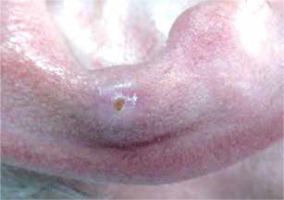Chondrodermatitis nodularis helicis (CN) (Winkler’s disease) is a benign disease characterized by a tender nodule located on the helix or antihelix [1–3] (Figure 1). Its relevance is based on causing pain, and because its differentiation with skin cancer is crucial. CN has been reported to be associated with diseases with vascular injury [1, 2] but not yet with human immunodeficiency virus (HIV) infection. Nevertheless, we empirically observed in studies concerned with this disease [2, 3] that some patients with CN also suffer from HIV infection. Building on this empiric hypothesis, we constructed this multicentric study aimed to compare for the first time the frequency of individuals with a confirmed diagnosis of HIV infection (and treatment) in patients with CN and in a matched control population. The investigation was limited to adult patients with a premature onset of CN lesions (≤ 61 years), because only this age subsample showed differences in a preliminary, unpublished study.
Figure 1
A tender nodule located on the helix, clinically and dermoscopically compatible with chondrodermatitis nodularis helicis

With this aim, we investigated the frequency of a confirmed diagnosis of HIV infection (and specific treatment) in the digital charts of adult patients with a premature histopathological diagnosis of CN (18 to less than 61 years at diagnosis); and in a sex, age, year of diagnosis (±2 years), and date of birth (±2 years) 1-to-2 matched control population of individuals with a histopathological diagnosis of seborrheic keratosis (SK), in the same two hospitals from Spain (HUCA, Oviedo, Asturias; HUMV, Santander, Cantabria); and in the same period (1 January 2000–31 December 2022). The study was approved by the Hospital Ethics Committee (ref. 111/18 and 2021.340). Digital charts were investigated for this outcome (frequency of a confirmed HIV diagnosis) until the end of the study (31 December 2022), death, or the last available date when the patient had visited the clinician. The same index date was assigned to cases and paired controls (±2 years). Statistical analyses were carried out in the free statistical software R1, version 4.0.3. For the descriptive analysis, continuous variables were expressed as median (Me) and interquartile range (IQR), and categorical variables were defined by their absolute value and percentage. Differences between samples were assessed by means of Fisher’s exact test.
Regarding our results, the frequency of individuals with a confirmed diagnosis (and treatment) of HIV infection was higher among patients with a premature diagnosis of CN than in the control population (p = 0.045; OR = 8.081; CI: 1.0405–-197.7301) (Table 1). Two patients with CN and one control individual with HIV died during the study period (Table 2).
Table 1
Characteristics of samples and frequency of human immunodeficiency virus (HIV) infection in cases (chondrodermatitis nodularis, CN) and controls (seborrheic keratosis, SK)
Table 2
Characteristics of the 4 patients presenting human immunodeficiency virus (HIV) infection among patients with early-onset chondrodermatitis nodularis (CN)
In this report, patients with a premature onset of CN lesions were more likely to be living with chronic HIV infection than a matched control population. Our findings are in line with the recent increase of diagnoses of benign lesions in patients with HIV infection after introduction of highly active antiretroviral therapies. CN is an idiopathic, exposome-induced, chronic, ischemic, degenerative and inflammatory disorder of the dermis/cartilage of the ear, with necrobiosis, transepidermal elimination and vasculopathy [1–3]. Age and chronic actinic damage favour its development [1–3]. CN is rare before 60 years of age at diagnosis (30%) and is rare in females (35%) [3]. This epidemiological study did not investigate causality, but different biologically plausible theories and pathomechanisms could explain this link: patients with HIV infection suffer from the premature occurrence of age-related comorbidities [4]. CN is an age-related disease and could be another one appearing earlier than usual in this context; tobacco smoking, more frequent among individuals with HIV, could favour both premature aging of patients [4] and premature development of CN lesions in HIV individuals [1]. In addition, CN is a vasculitis, and a relationship of CN with the spectrum of HIV vasculopathy (HIV-V) [5] could exist. In this way, a female patient with CN and HIV infection died from a ruptured thoracoabdominal aneurysm. Finally, therapy or the impact of other comorbidities, such as HCV coinfection, could be alternative pathomechanisms.
The strengths of this study were: multicentric design, confirmed histopathological diagnosis, the length of the study period, the size (it is the largest sample of CN patients evaluated to date); while limitations were: retrospective design, the small number of events; chance or bias cannot be excluded.
To conclude, in this pilot multi-centre study, adult patients with premature CN lesions were significantly more likely to be diagnosed with HIV infection than a matched control population. The importance of these findings for patients outweighs limitations and gives support for construction of larger, prospective, multicentric investigations.








